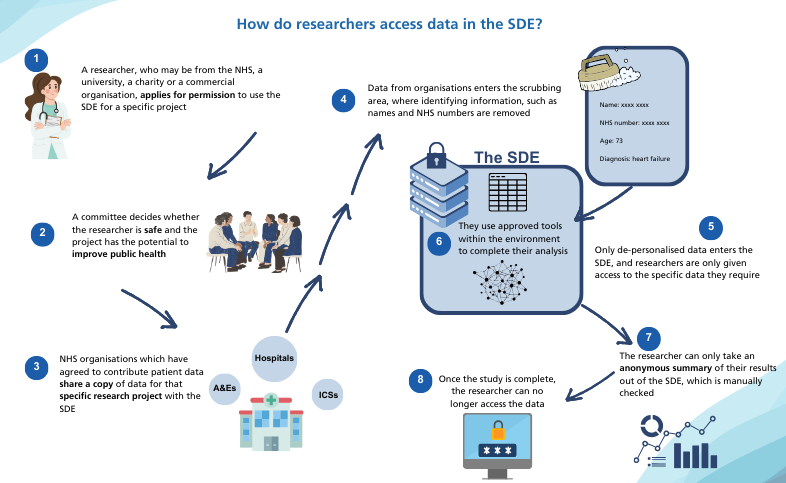Your NHS data, on its own, is used to help healthcare professionals give you the best possible care. When that data is combined with the data from other people it can be used to support research to create new and better treatments for everyone. Researchers can look for patterns and clues in combined health data to improve care for people with heart disease, cancer and other common health conditions. Because the NHS has data from so many people, it can even be used for research into less common conditions. Equally, data analysis is more likely to include information on groups of people who might otherwise find it difficult to take part in research.
The East of England Secure Data Environment (SDE) has been developed by the NHS, health and research organisations across the region to support the safe use of NHS patient data in a way that maintains patient privacy and that benefits public health and patient care. The SDE is specifically designed to drive improvements in the following areas:
- Prevention of illness
- Identifying risks to people’s health
- Predicting outcomes from treatment
- Personalising treatment approaches
- Patient and public participation in research studies and involvement in the use of data.
The East of England SDE is led by Cambridge University Hospitals NHS Foundation Trust in partnership with Health Innovation East.
Currently, when approved researchers apply to use NHS data for research, they are sent a copy of the de-identified or anonymised data required for their research. The secure data environment creates a way for researchers to access de-identified data in a controlled space, without having their own copy of the data. The data stay under control of the NHS while still allowing researchers to undertake their research.
The SDE platform creates a separate digital workspace for each research project that receives approval to access NHS data. The SDE has safeguards to ensure that researchers only receive access to the specific data required for their approved research, and they conduct their analysis within their dedicated workspace. Information that directly identifies individuals, such as names and NHS numbers are removed before researchers have access, and the SDE environment prevents data from being copied, changed, moved or deleted. Any results or outputs are manually checked before they are released to the researcher.
The SDE will provide a safe and efficient way for researchers to conduct vital health and care research, ultimately improving patient outcomes and fostering innovation within the NHS.
Because the data in the East of England SDE is derived from NHS patient records across the region, people from the area have been involved in the programme since the early planning phase. Public representatives also play a crucial role in the decision-making processes, determining who will be allowed to access data and for what purpose. This project builds on public involvement in earlier projects and brings together many organisations that are working to support trustworthy use of data in health research.

What is the NHS Secure Data Environment programme?
The East of England SDE is part of a national network of SDEs in England created to improve secure and efficient access to NHS data for research purposes. The network is developing common data standards, which will enable researchers to discover more about the data that is available and apply for access through a harmonised process.
Predicting the risk of hospital readmission for heart failure - the potential of the East of England SDE
The SDE team has collaborated with researchers and clinicians in Cambridge to support a study that required data about patients with heart failure. The project aims to develop a tool to predict the risk of patients’ readmission to hospital within 30 days of discharge following treatment for heart failure. This will enable clinicians to understand an individual patients’ risk of readmission for their heart failure so that action can be taken to avoid it, for example with additional supportive care. The project will demonstrate the potential of the SDE and use data from multiple NHS organisations to help researchers create tools that will improve health and care outcomes for patients.
Our partners in the SDE
Our partners in the SDE
- Cambridge University Hospitals NHS Foundation Trust
- Cambridge University Health Partners (CUHP)
- Health Innovation East
- Healthwatch
- Norfolk and Waveney ICS
- Cambridgeshire and Peterborough ICS
- Suffolk and North-East Essex ICS
- Bedfordshire, Luton and Milton Keynes ICS
- Hertfordshire and West Essex ICS
- Mid and South Essex ICS
- The University of East Anglia
- Anglia Ruskin University
- University of Cambridge
- Norfolk and Norwich University Hospitals
- North West Anglia Foundation Trust
- East of England Ambulance Services Trust
- Milton Keynes University Hospitals
- Kainos
- Amazon Web Services (AWS)
NHS patient data for research – what matters to you?
The SDE team want to know what is important to people when their NHS data is used for research and hear from them what health problems, they would like to see health researchers tackle using the data.
Please complete this anonymous survey to share your views.
For more information about the East of England Secure Data Environment, including how you can opt-out of your data being shared for research purposes, visit the SDE website.
Share your idea
Do you have a great idea that could deliver meaningful change in the real world?
Get involved